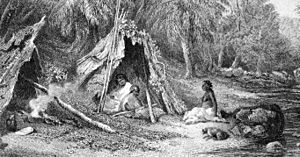Humpy facts for kids
A humpy is a simple, temporary home. It is also known as a gunyah or wurley. Australian Aboriginal people traditionally used these shelters. They made them from branches and bark. Humpies are often called a lean-to. This is because they often lean against a tree for support.
Contents
What is a Humpy?
A humpy is a basic shelter. It is built quickly and easily. People used them for short stays. They are not meant to be permanent homes. They offer protection from the weather.
Materials Used for Humpies
Humpies are usually made from natural materials. Builders use branches, leaves, and bark. Sometimes, grass or mud is also used. These materials are found nearby. This makes them easy to gather.
How Humpies are Built
Building a humpy is quite simple. First, a frame is made from strong branches. These branches are often leaned against a tree. Then, smaller branches and bark are added. They cover the frame to create walls and a roof. This makes the shelter waterproof.
Where Does the Name "Humpy" Come From?
The word "humpy" comes from an Aboriginal language. It is from the Jagera language. The Jagera people are a Murri group. They lived near Brisbane in Queensland. Other Aboriginal groups had different names for their shelters.
Other Names for Humpies
In South Australia, these shelters are called "wurley." This name might come from the Kaurna language. Both "humpy" and "wurley" became common words. Early European settlers started using them. Now, they are part of the Australian English language.
Modern Use of the Term
Over time, the meaning of "humpy" changed a bit. It can now mean any temporary building. These buildings are made from whatever materials are available. This includes things like canvas or old metal sheets.
Gallery
See also






